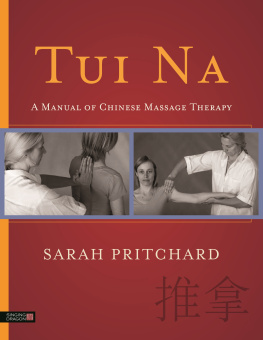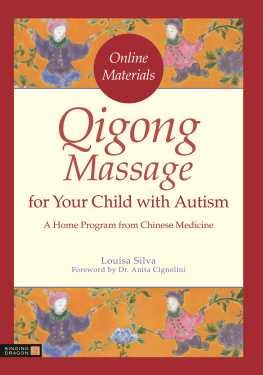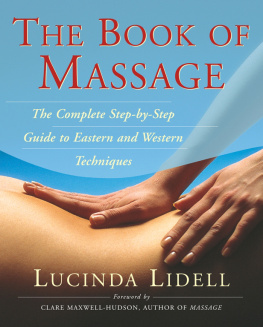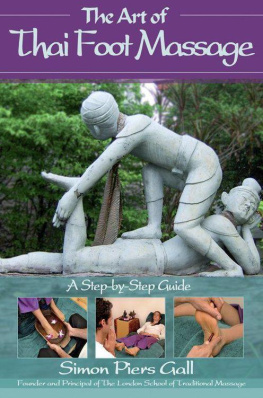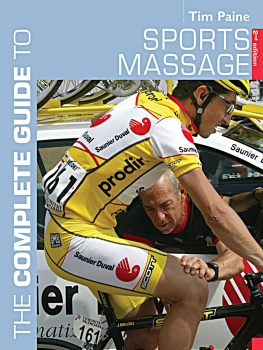
Tui na
by the same author
Chinese Massage Manual
A comprehensive, step-by-step introduction
to the healing art of Tui na
Sarah Pritchard
Foreword by Li He
ISBN 978 0 95629 300 8
eISBN 978 0 85701 217 3
of related interest
Tuina/Massage Manipulations
Basic Principles and Technique
Chief Editor: Li Jiangshan
ISBN 978 1 84819 058 0
eISBN 978 0 85701 046 9
Elemental Bodywork (Tuina)
Assessment and Application of Chinese
Massage through the Five Elements
Thomas Droge
ISBN 978 1 84819 244 7
eISBN 978 0 85701 189 3

Tui na
A MANUAL OF CHINESE MASSAGE THERAPY
Sarah Pritchard
Dip Tui na Clin.cert Tui na (Nanjing) Lic. Ac. MBAcC
Tui na Course Coordinator and Senior Lecturer, City College of Acupuncture, London;
Director, Blackheath Complementary Health Centre, London, UK;
Practitioner of Acupuncture, Tui na and Reiki
With a Contribution by Andrew Croysdale Dip Tui na MGCP MRCMT
Lecturer and Tui na Clinical Supervisor,
London College of Traditional Acupuncture and Oriental Medicine, London

LONDON AND PHILADELPHIA
This edition published in 2015
by Singing Dragon
an imprint of Jessica Kingsley Publishers
73 Collier Street
London N1 9BE, UK
and
400 Market Street, Suite 400
Philadelphia, PA 19106, USA
www.singingdragon.com
First published in 2010 by Elsevier Ltd
Copyright Sarah Pritchard 2010, 2015
All rights reserved. No part of this publication may be reproduced in any material form (including photocopying or storing it in any medium by electronic means and whether or not transiently or incidentally to some other use of this publication) without the written permission of the copyright owner except in accordance with the provisions of the Copyright, Designs and Patents Act 1988 or under the terms of a licence issued by the Copyright Licensing Agency Ltd, Saffron House, 610 Kirby Street, London EC1N 8TS. Applications for the copyright owners written permission to reproduce any part of this publication should be addressed to the publisher.
Warning: The doing of an unauthorised act in relation to a copyright work may result in both a civil claim for damages and criminal prosecution.
Library of Congress Cataloging in Publication Data
A CIP catalog record for this book is available from the Library of Congress
British Library Cataloguing in Publication Data
A CIP catalogue record for this book is available from the British Library
ISBN 978 1 84819 269 0
eISBN 978 0 85701 218 0
Printed and bound in Great Britain
Contents

There are videos which accompany this text including video sequences of all the techniques indicated in the text by the icon. These videos are available at www.singingdragon.com/catalogue/book/9781848192690/resources. The videos are designed to be used in conjunction with the text and not as a stand-alone product.
Chapter 4 Compound techniques
Oils
Preface
Tui na, or Chinese massage therapy, is one of the four main branches of traditional Chinese medicine. However, though its roots in China are ancient, it is still relatively new to the West. Archaeological studies have dated the use of Chinese massage therapy back to around 3000BC, making it the grandmother of all forms of massage and body work that exist today, from shiatsu to osteopathy, and the first form of Chinese medicine practiced.
Given this history, its popularity in China and the breadth of its therapeutic ability, it is perhaps surprising that it was the last branch of Chinese medicine to be recognized in the West.
I am glad that this situation is changing rapidly. When I was studying in the early 1990s, very few people in the UK and indeed throughout the West knew what Tui na was, and there was very little training available. Over the past 10 years this has been changing. Now, more colleges of Chinese medicine in the West have begun to offer Tui na practitioner training courses alongside their acupuncture and herbal medicine programs. It seems that Tui na is now entering another period of flourishing and development; this time in the West.
A recent survey conducted by the British Acupuncture Council about its members revealed that Tui na is now the most popular form of treatment for practitioners to use in conjunction with acupuncture. This shows a remarkable growth in the interest and popularity of Tui na among acupuncturists in the UK.
Many people in the West have been drawn to and helped by Chinese herbal medicine and acupuncture. As the popularity of Tui na spreads, more people will reap the benefits of this therapy, as they have done in China for thousands of years.
Tui na differs from other forms of massage in that it is used to treat specific illnesses of an internal nature as well as muscular skeletal ailments. Becoming a Tui na practitioner is a rewarding, if demanding process. You need a thorough knowledge of the theoretical principles of Chinese medicine and its channel system and points, a knowledge of Western anatomy, physiology and pathology, and the ability to perform a range of manual techniques according to your diagnosis.
This book is a comprehensive foundation textbook for students and practitioners of Tui na to help them with the process of acquiring the necessary manual skills and for developing the art of applying Tui na to adult patients. I hope this book will also be useful to acupuncturists and to practitioners of other forms of Oriental medicine and bodywork who are interested in learning Tui na. I have not covered infantile Tui na in this book this specialized branch of Tui na deals with the treatment of children under 7 years and I hope to cover this in a future book.
This book contains a detailed section on Tui na techniques including their clinical application and therapeutic effects. I believe in an integrated approach to Tui na and I have included information and examples of yin and yang styles of practice. There are also chapters on external herbal massage media and ancillary therapies. The final section of the book focuses on creating and planning Tui na treatments and how to apply them. Instead of using prescribed treatments I encourage you to formulate your own and I have given suggestions and guidelines, illustrated by many cases from my own practice.
Through my own experience of studying, practicing and teaching Tui na, I have discovered that there is always more to learn. As a student I learnt from my teachers, as a practitioner I learn from my patients, and as a teacher I learn from my students.
I hope this book helps you on the way to becoming an effective Tui na practitioner and encourages further progression and development of Tui na in the West.
Sarah Pritchard
London 2010
SECTION ONE 
Foundations
CHAPTER
Foundations and development of Tui na
Next page
